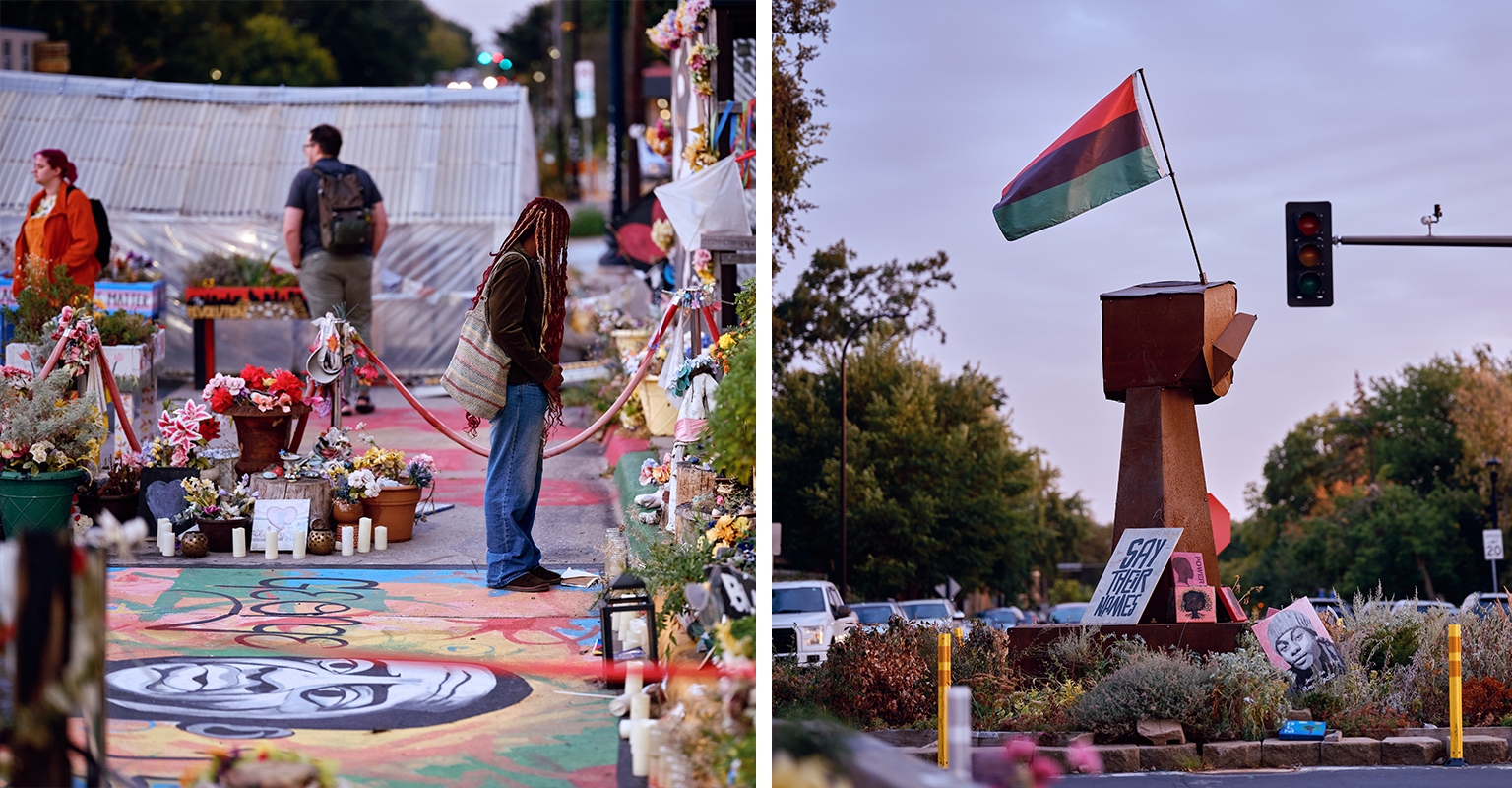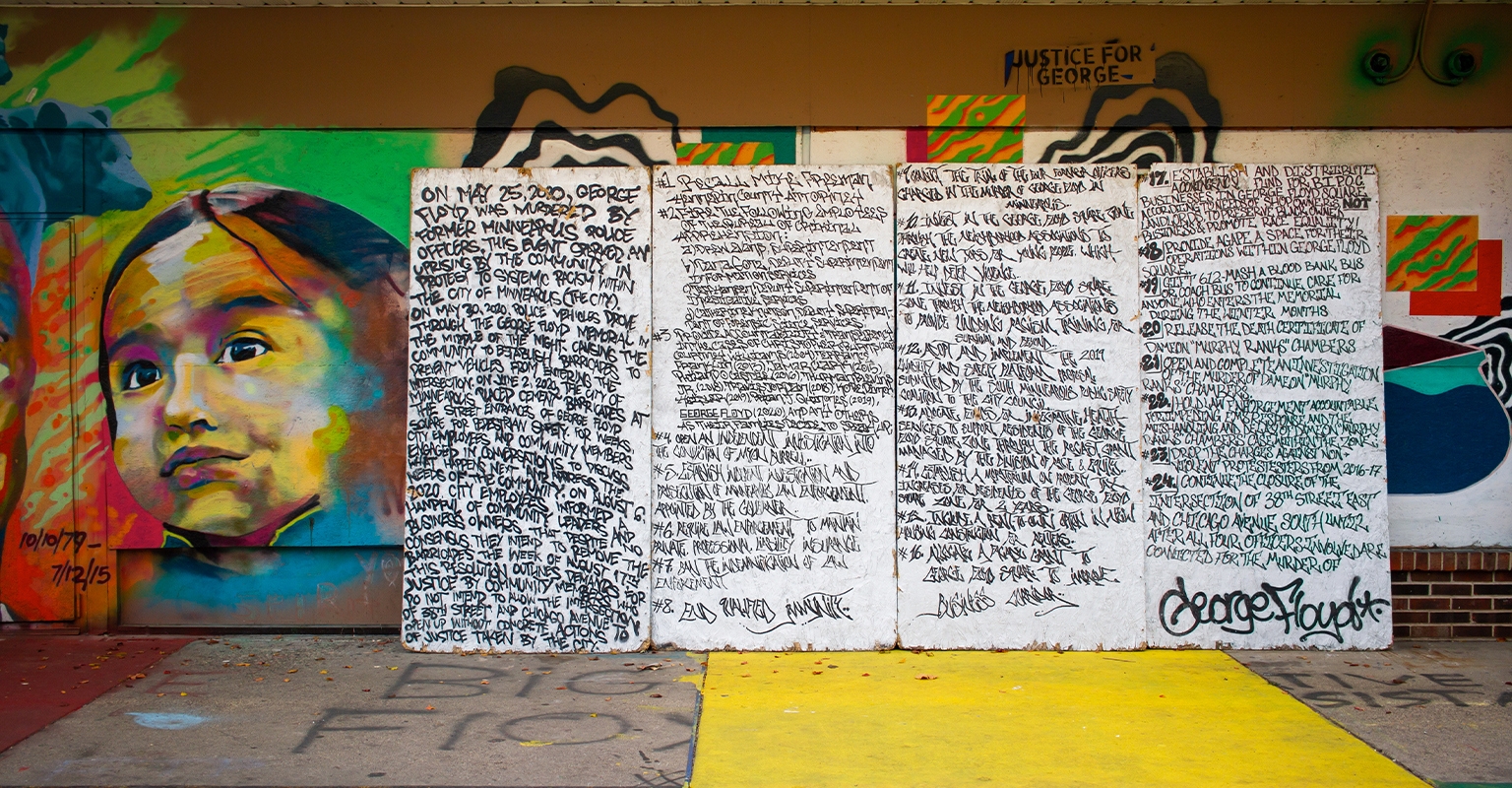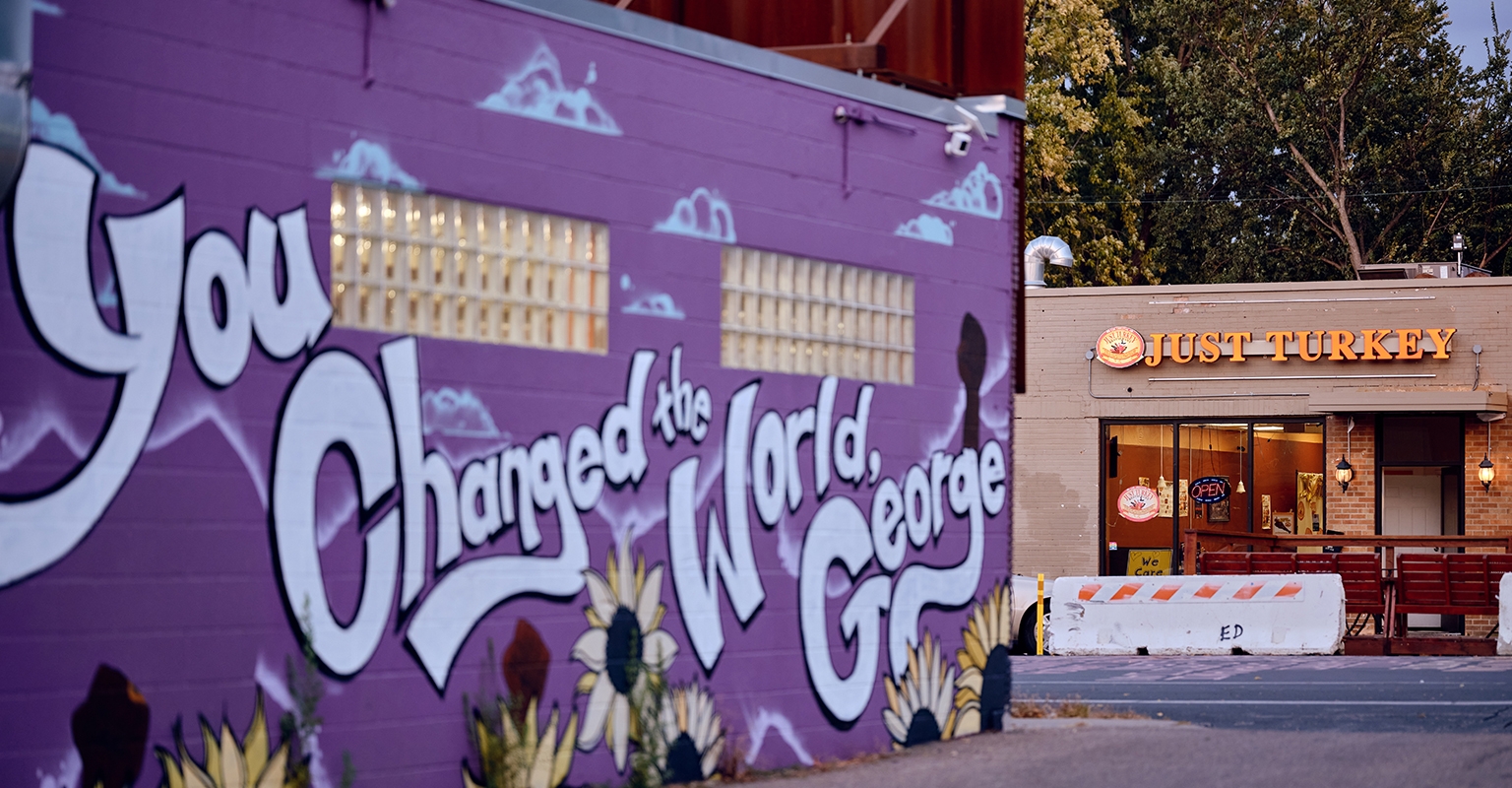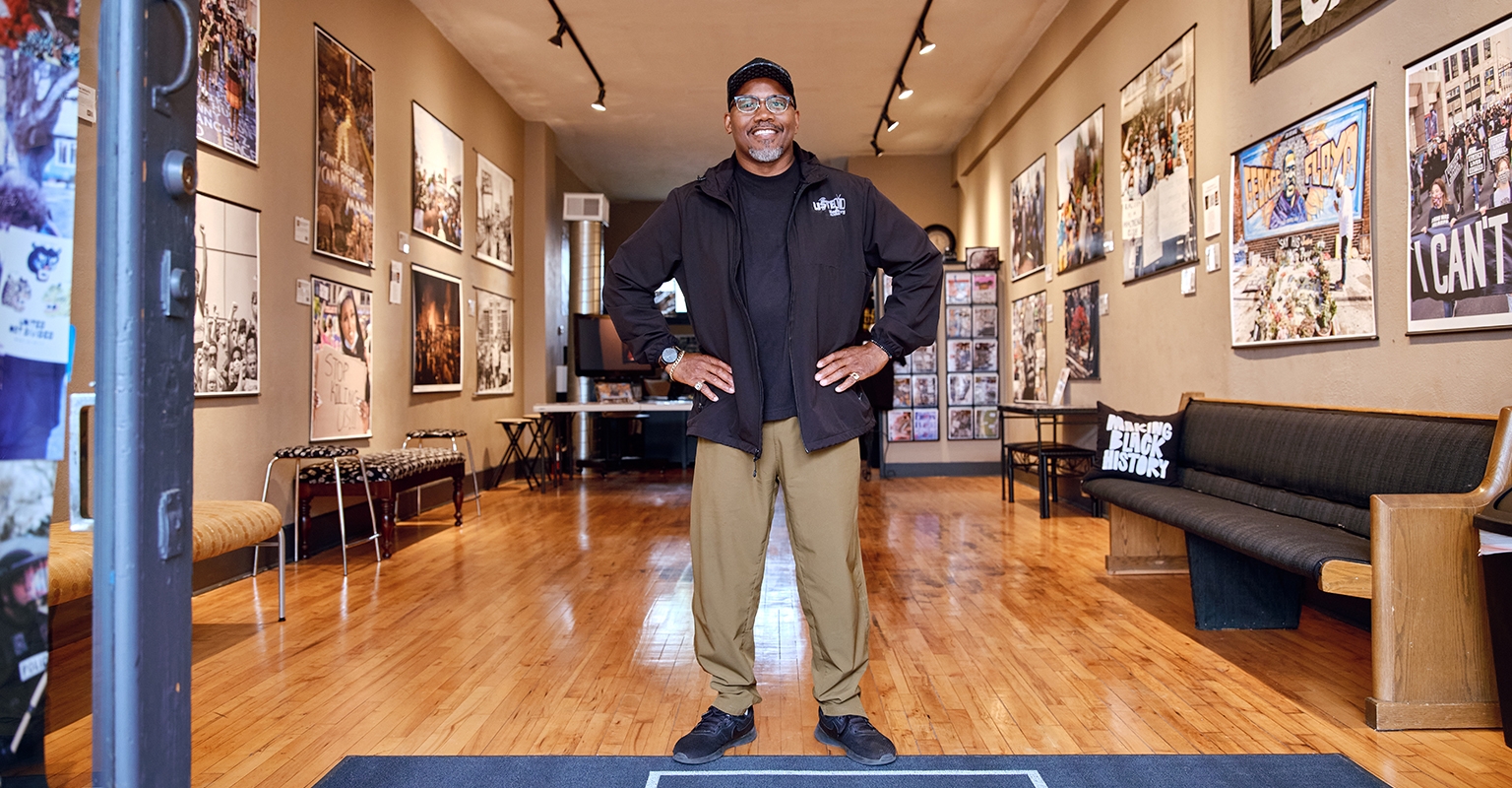Scenes from George Floyd Square: 5 Years Later
By Michael Kleber-Diggs
170 names of people who died at the hands of police are still painted on the street. The names are still legible, but they’re fading. At 38th and Chicago, the intersection where Mr. George Floyd was killed, the street signs were updated in 2022 to include a third sign which sits atop the traditional intersection markers and reads “George Perry Floyd Square”. Today, five years after the murder of George Floyd, the two blocks along Chicago Avenue that were officially designated to help us remember Mr. Floyd and how and where he was killed are largely the same as they were when the square was first established in 2020.
In the middle of the intersection, Jerome Powell Karis’s “Black Power” fist remains, resolute. This version, which Karis fabricated out of iron in 2021, to replace the makeshift one he’d first made out of plywood, was assembled with support from artists at the nearby Chicago Avenue Fire Arts Center. Cars approaching the intersection from any direction are required to stop. They now curve around a small garden at the base of the statue as if it were a roundabout. Karis’s plywood template remains in the intersection at 37th and Chicago, faded by time, made more poignant for how it has warped a bit and weathered. A third fist presides at 39th Street, the southernmost end of the square.

George Perry Floyd Square endures as a gathering place, and, like those iconic fists, many of the foundational features that have made the avenue an essential space for community gatherings, are still there. The memorial at the specific site where Mr. Floyd was killed, is still filled with flowers—real and synthetic. The area has been cordoned off by barricades, allowing visitors to take their time to pay respects as traffic flows by.
A few feet away, a sturdy greenhouse bustles with floraculture to source the gardens and the memorial. The greenhouse isn’t often open to the public, but the protective exterior and roof are designed to let sunlight in. They can allow visitors to gather a glimpse of what’s growing inside. I visited the square on one of those ‘April showers’ days and spied yellow daffodils within, getting ready to make their May debut.
Next, I stopped in Unity Foods, formerly known as Cup Foods. It was my first time shopping there. I bought some peanut m&m’s to carry with me as I walked around, and, because I could not help it, an afro pick with a fist on it. As families from the neighborhood shopped grocery and convenience aisles, as a few folks dined at the small restaurant inside, it almost seemed like business as usual. When I settled up, the store owner asked how I was doing and told me to have a good day.
I wished him well then walked across the street to the site of what was a convenience store, what is now known as People’s Way. The City of Minneapolis acquired the People’s Way property in 2023, and has received proposals from nonprofits for its future use. Four plans are under consideration: a building devoted to civil resilience, a memorial garden, a community center, and a space for community resources, to include a George Floyd Museum.
The original 24 Demands which were posted on the facade of People’s Way are still there. Many of those demands remain in progress, although some have been met—including bringing the officers to justice, investing in George Floyd Square, providing space for community organizations, and preserving the square as a memorial.
While those plans play forward, the free library that was installed at People’s Way five years ago is still open and still full of books. There’s still a place to donate and receive free clothes. There’s still an area off to the side to support gardens at the square, and the bus stop is still an information kiosk.
Here’s an insider tip: stop by the kiosk. It might not look like much, but on the southern wall, there’s a sign with a QR code that connects to a Voice Map walking tour called Days of Rage, Night of Fire: A History Tour of Midtown Minneapolis. The tour features an informative history of the area, featuring interviews and personal stories from residents and business owners who were there on the fateful afternoon of May 25th, 2020. As you listen, make sure not to miss the powerful pieces shared by two celebrated Minnesota writers, a poem called “Powderhorn” by Ed Bok Lee and a short essay by Shannon Gibney called “Minneapolis, Revisited.”

People Come from All Over
I visited on a pleasant weekend near the end of a summer of drought. I parked near the Baha’i Center of Minneapolis and entered the square from the north. I was there near midday, and 50 or so people were there at the same time—honoring George Floyd, taking photos, or talking to Charles McMillian, a witness to George Floyd’s murder who rose to prominence for his testimony at trial. I heard him tell a Black family—two parents and three children—where he was standing when he spoke to George Floyd, when he told him “you can’t win.”
Most people seemed grave and introspective as they explored the features of the square. People come from all over the world to visit the site or include it as part of their visit to the Twin Cities. While I walked around, I heard visitors from the Netherlands speaking Dutch, and I talked to a Black grandmother from Milwaukee named Tischa Brown. She came to Minneapolis specifically to see George Floyd Square and spoke to me of the challenges of honoring life and death at the same time in the same place.
As you enter the space from the north, you’ll see, painted on the street in white text atop black panels, the 24 protester demands that were presented to the city in August of 2020, demands people wanted to see met before the street was reopened to vehicular traffic.
Just beyond those, in large colorful, carefully painted capital letters are the names of several people who have lost their lives to police violence. That list of names runs the length of the block. George Floyd is centered in everything that’s happening at the square named in his honor, and, at the same time, the area is in memoriam to others who lost their lives, a reminder that what happened to George Floyd was part of a larger epidemic of unnecessary and lethal police violence.

Things to Do Nearby
During your visit, make sure to see the “Say Their Names Cemetery,” one block north and one block west of George Floyd Square at 37th and Columbus. It was made by Anna Barber and Connor Wright. In a small park near 37th Street and Park Avenue, visit Say Their Names Cemetery, a public art installation as a memorial honoring Black people who have lost their lives to police violence. The cemetery, which was created one month after Mr. Floyd was killed, is still there today. Where once it held 100 tombstones, it now has nearly 160.
Around George Floyd Square, there are businesses that are worth your attention. On the west side of the street is Listen 2 Us art gallery and media studio founded by internationally recognized photojournalist and activist, KingDemetrius Pendleton, who focuses on "documenting our history for posterity". Smoke in the Pit is a highly rated Black-owned barbecue restaurant on the east side of the street.
Art endures as a way we remember Mr. Floyd. Many of the iconic murals that first graced the square are still there. Many more have been mapped by the George Floyd and Anti-Racist Street Art archive diligently gathered by Urban Art Mapping. Area artists have set up shop or remained on Chicago Avenue. One half block north of the memorial site, stop by the trio of art galleries which includes: KingDemetrius Pendleton’s Listen 2 Us Studio features a George Floyd Square Exhibit, Third Place Gallery, a long-standing Chicago Avenue gathering space led by celebrated photographer, Wing Young Huie, and Plot Gallery which recently relocated to the square.

Why We Remember
Memorials we make after murders will always include a measure of sadness and regret along with the possibility for joy. Those 24 Demands can read like warnings now. And if we don’t remember this history, if we don’t learn its lessons, we might suffer more unnecessary losses. As we remember, we also make room for celebrations, a brass band often graces the space with music, and there is a music festival hosted there every year.
As I left George Perry Floyd Square, my main takeaway was this: the work continues. Good people are still there working to imagine better and to make a better and safer world a reality. And whether we are driving through, stopping for dinner, volunteering, grabbing a book, dropping off clothes someone else might use, enjoying art on the streets or in galleries nearby, making music or attending a concert, planting flowers or leaving a bouquet, we are remembering. As we remember, we honor Mr. Floyd. We can’t undo the tragedy, but we can allow it to propel us toward justice.


